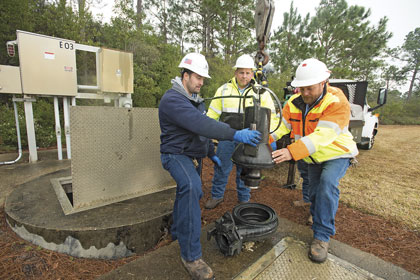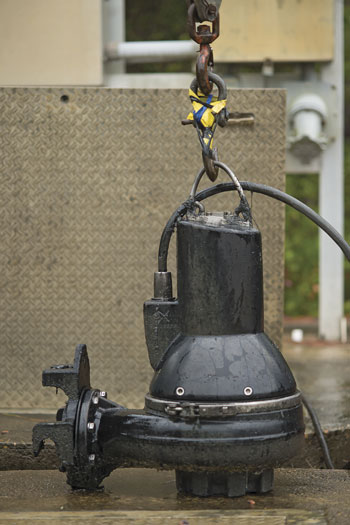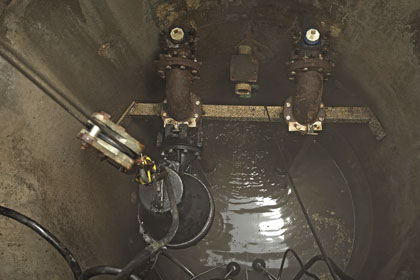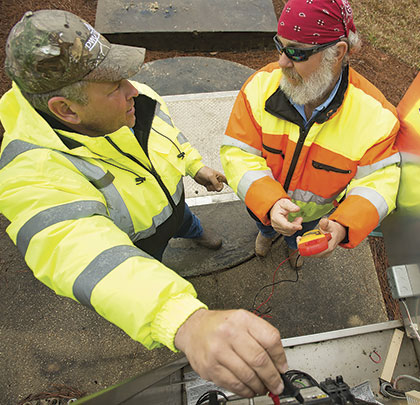Wastewater managers know too well that clogged pumps are not only an inconvenience, but also a threat to an entire wastewater transport system.
If management misses a clog alarm, the flow can rise up the well and out of the manhole. The result is a public health issue, as sewage may contain everything from fecal matter and urine to blood and viruses. Besides the added labor costs, wear caused by chronic clogging can lead to premature pump failure and an unplanned capital expense. If the station is unable to keep up with demand, the cascading impact on nearby stations can turn into a wastewater nightmare.
Obviously, keeping a smooth flow through the lift station is a top concern for municipal wastewater managers. That, of course, demands wastewater pumps that will handle the required flow at the specified head, pumps that will pass solids without failing, day-in and day-out, and that will never require a 1 am phone call or overtime service on a three-day weekend.
Conventional wastewater pumps can disappoint under such demanding circumstances, but two recent retrofit projects in the Florida panhandle—in DeFuniak Springs and Destin—demonstrate how leading-edge pump technologies from Grundfos can eliminate clogging and raise efficiencies, while reducing utility, maintenance and labor costs—in even the most challenging projects.

A recent wastewater lift station that was retrofit with the solids-handling Grundfos SL1 wastewater pump demonstrates how leading-edge pump technologies can eliminate clogging and raise efficiencies while reducing utility, maintenance, and labor costs.
SOFTBALL-SIZED BALLS OF GREASE
DeFuniak Springs is a small city an hour’s drive east of Pensacola. A lift station serving the Oakdale apartment complex was constantly clogging with softball-sized balls of grease and goo, reducing pressure so much that the 4-inch conventional two-vane, non-clog pump struggled to overcome the 16 feet of static head.
Oakdale, with 252 housing units (50 single-family homes and 202 apartments), is the type of high-density residential complex that places big demands on a wastewater pump.
“Lots of apartments with lots of people cooking most meals at home generates a lot of grease,” says Jayne Swift, project manager for CH2M Hill, the company that operates the municipality’s wastewater system. “If a pump won’t pass grease it will plug up.” She also notes that people will flush anything down the toilet that will fit.
Swift turned to Fort Walton Beach-based Gilbert Pump and Mechanical, a distributor with twenty-five years’ experience, for a solution to the persistent clogging. Gilbert Principal Brian Widman learned that nearly every day, two workers would have to drive to the Oakdale lift station, pull the pump, vacuum it out, and lower it back down into the wet well. The minimum costs for such visits range anywhere from a couple hundred dollars to sometimes thousands of dollars, a definite strain on the community’s maintenance budget.

Close-up view of the Grundfos SL1 wastewater pump.
THE RECOMMENDATION
After analyzing the demands on the station, Gilbert Pump and Mechanical recommended a pair of 4 horsepower, 1800 rpm Grundfos SLV pumps, each of which had a capacity of 125 gallons per minute at 25 feet of total dynamic head (TDH). To overcome prior difficulties with clogging, the team selected the optional SuperVortex pump impeller, to manage the housing complex’s unusually high solids volume.
“The beauty of this impeller is that it works by not touching the solids,” explains Widman. “Instead, it creates a vortex that moves effluent through the pump, allowing for greater free passage of solids.”
Gilbert Pump selected the optional SuperVortex impeller to help ensure that solids up to 4 inches in diameter pass freely through the pump without jamming. The unique winglet-vane SuperVortex impeller is ideal for larger solids, because of its recessed position and the fact that the water and debris don’t actually pass through the impeller. Although not as energy efficient as channel-style impellers, Widman notes that passing solids, not energy consumption, was the overriding challenge for the Oakdale lift station.
The two SLV pumps at Oakdale, which are designed to handle raw sewage, grit, fibrous materials, and drainage water, are submersible wastewater pumps that are staged to alternate each time the station comes on (in order to share the workload). Features include a short rotor shaft to minimize shaft deflection and vibration, a cartridge style double mechanical seal for reduced maintenance time, and an easy-to-open clamp for access to the pump housing. The pumps are controlled by level sensing float switches and a duplex control panel with variable speed drives used for phase conversion.
The SLVs completely solved Oakdale’s clogging problem: They have been in place for more than three years without needing a single cleanout, and Operator Swift couldn’t be happier. “The SLV is a great pump for a demanding application like an apartment complex,” she says. “It really reduces the amount of required maintenance.”

Keeping a smooth flow through the lift station is a top concern for municipal wastewater managers.
A LOOK AHEAD
In next month’s conclusion, we’ll examine a similar pump failure that took place about six hours across the Panhandle, where a private, non-profit utility serving Destin, Florida, and parts of Okaloosa County was struggling with extended run times and pump fouling. Destin Water Users, Inc., a private, non-profit utility, found that a new Grundfos SL1 wastewater pump provided the solution they were looking for. ◆
For More Information
Grundfos Pumps Corporation, part of the Grundfos Group, is a global pumps and pumping systems leader serving the residential, commercial-building, and process-industry markets, as well as being a major supplier to the water-supply and water-treatment industries. Founded in 1945 in Bjerringbro, Denmark, The Grundfos Group is a worldwide enterprise that employs more than 18,000 people in 81 countries with North American headquarters in Downers Grove, Illinois. For more information, visit www.grundfos.us.
____________________________________________
MODERN PUMPING TODAY, January 2016
Did you enjoy this article?
Subscribe to the FREE Digital Edition of Modern Pumping Today Magazine!
![]()


